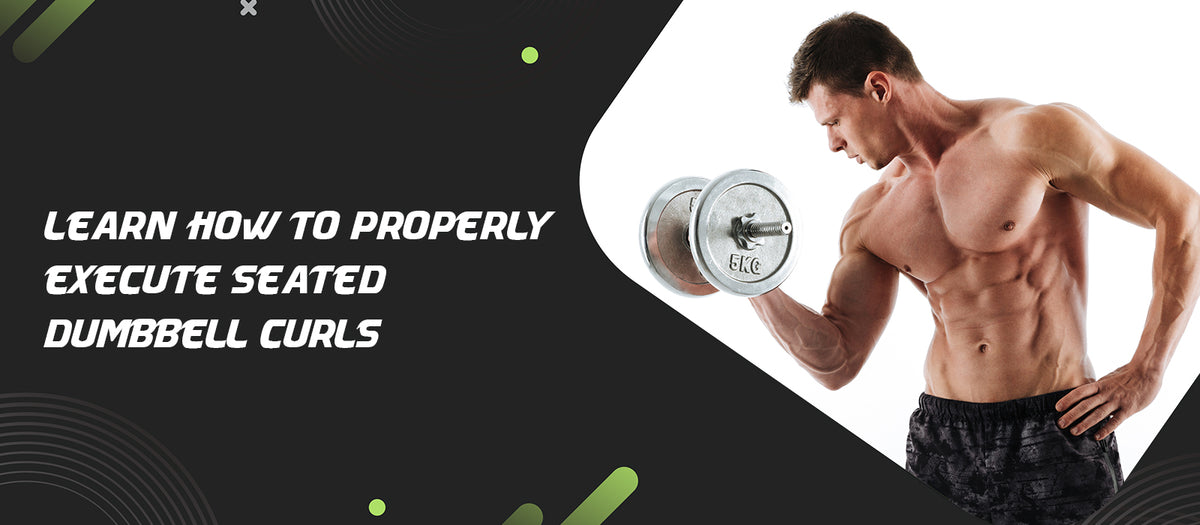Master the seated dumbbell curls and learn what other exercises will help one build big, powerful, sleeve-popping biceps!
The Beginner’s Guide to Mastering Seated Dumbbell Curls What Are Seated Dumbbell Curls? The seated dumbbell curl is perhaps one of the first arm exercises any beginner will learn at the gym. It’s simple, easy to learn, and best of all, effective.
Perhaps the biggest difference between standing and seated dumbbell curls is the latter relaxes the hips. As a result, you won’t be able to cheat reps by swinging your waist every time you are bringing the dumbbells up.
How to Do Seated Dumbbell Curls

Step 1: Warm Up the Arms The seated dumbbell curl is an intense exercise that’s a bit heavy on the elbows so make sure to warm them up before working out. Otherwise, you might end up with a painful arm sprain.
A few upper body dynamic stretching exercises should be fine, but try not to do more than 10 reps per set. If you can do 10 reps easily, it’s time to increase the weight.
Step 2: Choose the Dumbbells

Choosing the correct dumbbells is vital to ensure you can keep good form for every rep.
Beginners should start with dumbbells that would limit them to about 12 to 16 reps. Going too heavy will only put your form at risk. Meanwhile, going too light won’t give properly work your muscles.
Note: Don’t be afraid to try out all kinds of dumbbells. After all, the only way to find out what weight would suit your body the best is to explore the options.
Step 3: Get into Position
After choosing what weight to use, grab the dumbbells with a neutral grip, sit on the edge of a flat bench, keep your back straight, face forward, and let your arms hang at your sides with your palms facing in towards your body.
Step 4: Curl the Dumbbells Up and Down
While keeping the back straight and upper arms still, curl the dumbbells up towards your shoulders. Make sure to twist the hands so that the palms end up facing the shoulders.
At the top, pause, contract the biceps and then lower the weight down slowly while twisting the hands back to their original position. This is one rep.
Bodybuilders who want to add muscle mass to their arms can do 4 to 5 heavy sets of 5 to 8 reps. On the other hand, fitness buffs who want to slim down and tone up their arms can use lighter dumbbells and do 3 to 4 sets of 16 to 20 reps.
Note:Remember not to extend the arms out fully as it relaxes and disengages the biceps. The arms should be contracted all throughout the movement.
Bicep-Building Workout Moves

No matter how great seated dumbbell curls are, you need to switch up your exercises for maximum gains. Other arm exercises to include on biceps day are:
1. Seated Dumbbell Hammer Curls
A seated hammer curl is very similar to a dumbbell curl. In fact, the only difference is the wrists won’t twist during a hammer curl.
It might seem like a small, insignificant difference, but it actually has a huge effect on how the exercise targets the body.
The biceps have two parts: the long and short head. Hammer curls target the long head of the biceps. Working this part makes the arms look larger and thicker.
Meanwhile, dumbbell curls primarily work the short head of the biceps. Athletes who want to add shape and definition to their biceps should definitely bust out a few sets of these regularly.
How to:
- Assume the same starting position as the seated dumbbell curls.
- Slowly curl both dumbbells up to the height of the shoulders while keeping the back straight, upper arms stationary, and palms facing the body.
- Contract the biceps and then lower the weights back down. This is one rep
2. Seated Alternating Dumbbell Curls

By alternating between the left and right hand, bodybuilders will be able to isolate and target the biceps even further.
How to:
- Assume the same starting position as the seated dumbbell curls.
- While keeping the upper arms stationary, curl the right dumbbell up to the height of the shoulders.
- Pause and then slowly lower the weight down. This is one rep.
- Alternate between the left and right hand.
Note: To make it more challenging, curl one dumbbell up while simultaneously lowering the other dumbbell.
3. Seated Barbell Curl

Seated barbell curls trump regular dumbbell and barbell curls when it comes to adding biceps size and mass. By cutting the range of motion in half, the athlete solely targets the biceps.
How to:
- Sit on the edge of a flat bench with the back straight, eyes locked forward, and a loaded barbell on top of the knees.
- Grab the bar with an underhand grip and keep the bar as close to the waist as possible.
- Keeping the upper arms stationary, curl the weight up to the height of the shoulders.
- During the curl, the bar should drag upward across the body.
- At the top, pause for one count before slowly returning to the starting position. This is one rep.








mdndrqfiwn
April 05, 2025
Muchas gracias. ?Como puedo iniciar sesion?